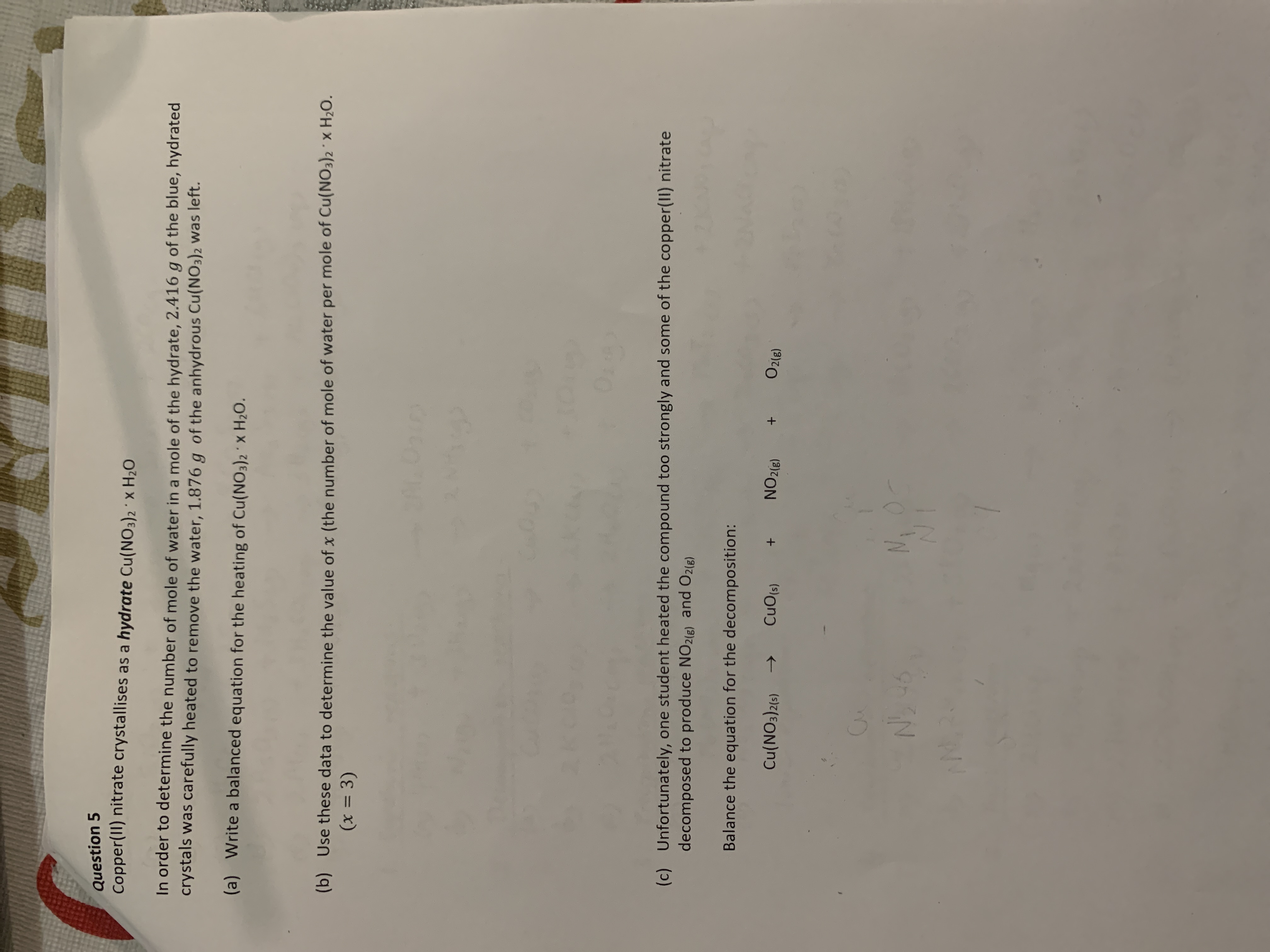
Chemistry
10th Edition
ISBN: 9781305957404
Author: Steven S. Zumdahl, Susan A. Zumdahl, Donald J. DeCoste
Publisher: Cengage Learning
expand_more
expand_more
format_list_bulleted
Concept explainers
Question

Transcribed Image Text:Question 5
Copper(II) nitrate crystallises as a hydrate Cu(NO3)2 ' x H20
In order to determine the number of mole of water in a mole of the hydrate, 2.416 g of the blue, hydrated
crystals was carefully heated to remove the water, 1.876 g of the anhydrous Cu(NO3)2 was left.
(a) Write a balanced equation for the heating of Cu(NO3)2 X H2O.
(b) Use these data to determine the value of x (the number of mole of water per mole of Cu(NO3)2 x H2O.
(x = 3)
%3D
(c) Unfortunately, one student heated the compound too strongly and some of the copper(II) nitrate
decomposed to produce NO2(E) and O2(e)
Balance the equation for the decomposition:
Cu(NO3)2(5)
CuO(s)
NO2(8)
O2(e)
Expert Solution
This question has been solved!
Explore an expertly crafted, step-by-step solution for a thorough understanding of key concepts.
This is a popular solution
Trending nowThis is a popular solution!
Step by stepSolved in 5 steps with 5 images

Knowledge Booster
Learn more about
Need a deep-dive on the concept behind this application? Look no further. Learn more about this topic, chemistry and related others by exploring similar questions and additional content below.Similar questions
- Treatment of a 0.3500-g sample of impure potassium chloride with an excess of AgNO3 resulted in the formation of 0.3846 g of AgCl. Calculate the percentage of KCl in the sample.arrow_forward7. Balance the following equation; C+0, → CO,arrow_forwardIf 2.952 g of copper(II) nitrate is reacted with sufficient sodium hydroxide, how much copper (II) hydroxide will be produced?arrow_forward
- Elemental iron is produced according to the following reaction: Fe2O3(s) + Al(s) ---> Al2O3(s) + Fe(s) If 5.34 g Fe2O3 is allowed to react with excess Al, what is the theoretical yield of elemental iron for this reaction? A) 0.934 g B) 1.87 g C) 3.73 g D) 6.82 garrow_forwardWhich of the metals (Fe, Zn, Mg) will react in an aqueous solution of AL(NO3)3 to produce aluminum meatal?arrow_forwardA3) Balance the following equation. You must enter a number in every blank. Fe(s) + O2lg) → Fe3O4(s)arrow_forward
arrow_back_ios
arrow_forward_ios
Recommended textbooks for you
 ChemistryChemistryISBN:9781305957404Author:Steven S. Zumdahl, Susan A. Zumdahl, Donald J. DeCostePublisher:Cengage Learning
ChemistryChemistryISBN:9781305957404Author:Steven S. Zumdahl, Susan A. Zumdahl, Donald J. DeCostePublisher:Cengage Learning ChemistryChemistryISBN:9781259911156Author:Raymond Chang Dr., Jason Overby ProfessorPublisher:McGraw-Hill Education
ChemistryChemistryISBN:9781259911156Author:Raymond Chang Dr., Jason Overby ProfessorPublisher:McGraw-Hill Education Principles of Instrumental AnalysisChemistryISBN:9781305577213Author:Douglas A. Skoog, F. James Holler, Stanley R. CrouchPublisher:Cengage Learning
Principles of Instrumental AnalysisChemistryISBN:9781305577213Author:Douglas A. Skoog, F. James Holler, Stanley R. CrouchPublisher:Cengage Learning Organic ChemistryChemistryISBN:9780078021558Author:Janice Gorzynski Smith Dr.Publisher:McGraw-Hill Education
Organic ChemistryChemistryISBN:9780078021558Author:Janice Gorzynski Smith Dr.Publisher:McGraw-Hill Education Chemistry: Principles and ReactionsChemistryISBN:9781305079373Author:William L. Masterton, Cecile N. HurleyPublisher:Cengage Learning
Chemistry: Principles and ReactionsChemistryISBN:9781305079373Author:William L. Masterton, Cecile N. HurleyPublisher:Cengage Learning Elementary Principles of Chemical Processes, Bind...ChemistryISBN:9781118431221Author:Richard M. Felder, Ronald W. Rousseau, Lisa G. BullardPublisher:WILEY
Elementary Principles of Chemical Processes, Bind...ChemistryISBN:9781118431221Author:Richard M. Felder, Ronald W. Rousseau, Lisa G. BullardPublisher:WILEY

Chemistry
Chemistry
ISBN:9781305957404
Author:Steven S. Zumdahl, Susan A. Zumdahl, Donald J. DeCoste
Publisher:Cengage Learning

Chemistry
Chemistry
ISBN:9781259911156
Author:Raymond Chang Dr., Jason Overby Professor
Publisher:McGraw-Hill Education

Principles of Instrumental Analysis
Chemistry
ISBN:9781305577213
Author:Douglas A. Skoog, F. James Holler, Stanley R. Crouch
Publisher:Cengage Learning

Organic Chemistry
Chemistry
ISBN:9780078021558
Author:Janice Gorzynski Smith Dr.
Publisher:McGraw-Hill Education

Chemistry: Principles and Reactions
Chemistry
ISBN:9781305079373
Author:William L. Masterton, Cecile N. Hurley
Publisher:Cengage Learning

Elementary Principles of Chemical Processes, Bind...
Chemistry
ISBN:9781118431221
Author:Richard M. Felder, Ronald W. Rousseau, Lisa G. Bullard
Publisher:WILEY